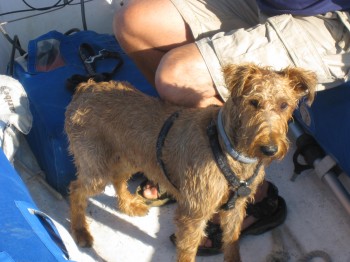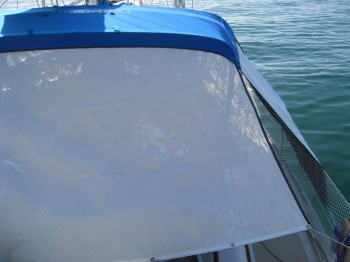Please note: We are not an authority on what you need to travel with a dog. We are learning as we go along.
Every dog, boat and sailing style is different. We have only posted this because we found it difficult to get ‘helpful’ information before we set off.
Please pick out what you find helpful and ignore the rest.
Please feel free to add useful information and links for others in the comments section.
That said:
What do you need to sail around the world with a dog?
Day to day necessities
*Spill proof water bowl, preferably non-slip.
*Plastic food bowl, preferably non-slip
*Harness rather then a collar for your dog. We use the harness as a handle to move or guide the dog in and out of the dingy and up onto the boat.
*Lead
*Storage box for dry dog food. We found on that fits right under the bottom step and is secured into place with a shock cord.

Dog food stored in a water proof container that fits under our galley stairs.
A shock cord stops it moving about in rough seas.
*Dog bed that is easy to clean. We got the ones with zipper off covers so we only have to clean it and not all the stuffing. We have a zipper on waterproof canvas cover for the cockpit bed.
*Toy box or cupboard. Try to bring out different toys at different times. Variety is the spice of life on a boat.
*Poo bags. Remember you are a guest in their town or city.
*Play time. We find Quinn is most ‘frisky’ in the dawn and dusk hour. We have play time built into our watch schedule. This is as important as food and sleep to many breeds of dog.
*Towel(s). For drying, staying warm on night watch and for rubbing off sandy belly’s.
*Sturdy bucket on a warp. To scoop up buckets of sea water to wash away wee, sand, mud or just cool off on passage.
*Dog life jacket. Get one, or have it altered, so that it fits comfortably, offers some under belly support while still alowing the dog to ‘do it’s business’.

Get a life jacket that fits your dog well and is comfortable.
Try to get one with lots of tummy support and big handles.
Things to stock up on
*Dry dog food. It is available almost everywhere, but if your dog likes a specific brands, finding it can be hard. Remember, variety is the spice of life, and you would not want to eat the same thing every day, all the time.
*Raw hides and chews. They have been hard to find. Chewing releases endorphins and relaxes your dog. If the weather gets a bit rough or the dog appears a little stressed we lather one up with cheese or peanut butter to get the dog to start chewing. Works a treat.
*Types of toys your dog likes to play with. We found tennis balls especially hard to find.
*Poo bags.
*Medications. Speak to your vet and he will give you a list of medications you will need. We use the broad spectrum anti-parasite drops Advocate once a month for most things including fleas. Drontal once every 3 months for worms and a Seresto collar for sand fleas, lice and ticks that lasts 6-8 months. Advocate makes Quinn very ‘spaced out’ for a day so we are careful to give it to him on days he can relax and never mix medications on the same day. I carry Metacam for pain and inflammation, because the liquid form is so easy to measure and give to the dog. I also carry his own supply of anti-histamine in case of a bad reaction to a plant or sting.
*Consider taking a pet medical training day. They are hard to find and are usually only offered by vet surgeries 1-2 times a year, so research it now and book it.
*Extra harness and lead. They are available at most places, but you know you will drop one in the water when one is not available.
Training
There are a variety of sources with great training ideas, so we will not go into any detail on the blog. We took Quinn to dog training classes at School for Dogs in Brighton, UK. Jo has her own web site and You Tube videos to help with training. We used her reward based training methods on Quinn, but broke down and threaten him with the water pistol if he will not stop barking. That is Terriers for you!
*Train your dog to toilet on the boat. This is the number one problem people travelling with a dog have.
*Train your dog to be comfortable in a life jacket. You do not want him to associate the jacket with rough conditions and get stressed.
*Train your dog to settle on his bed on command. We use it to keep the dog out of the way when we are doing sail changes or if there is any danger he could be injured.
Training him to settle under a table on command is also handy at cafes and resturants as we have run into a lot of servers scared of dogs. The dog is also less likely to get stepped on.
*Train your dog to sleep with his harness on.
*Teach your dog to play with you. You are not going to have long walks to tire your dog any more. Teach your dog to play with you. Tuggy, hide and seek and scent training are all manageable even on the smallest of boats.
*Train your dog to eat dry dog food. It is just as nutritious as wet dog food, but much better for their teeth. No use paying more for the water and, unless you are lucky enough to have a big boat, dry dog food takes up less space.
*Train your dog to come when called.
*Train your dog to stop and freeze on command. We have used this command so many times we can not tell you how handy it is and how many times it has saved the dogs life.
*Socialise your dog with a variety of people of different ages, sexes and nationalities.
*Train you dog to bark and stop barking on command. You want your dog to protect and warn you of danger, but the other boat owners on the anchorage will not be happy with you if he does not stop barking.
*Train your dog to be left alone. Dogs are naturally a pack animal and being calm, comfortable and relaxed about being left alone IS a learned behaviour that takes gradual training for the majority of dogs.
Alterations to boat
*Boat hook in a handy and easily released spot. Do a practice dog overboard drill and see if you can lift him with it. If you can not you will need to design an alternative way to lift him aboard.
*Make or find a small secure place for the dog to rest and sleep. Some place the dog can curl into even on the roughest of nights and feel safe. We have Quinn’s bed under the galley table. He has his own lee cloth that extends from the tables central leg across one side so he can wedge himself in. The table top protects him from objects falling out of selves. Another dog owner here told me his dog likes the forepeak wedged in with the sail bags.

Dogs bed under the saloon table.
The a canvas lee cloth (now wrapped around the table leg) pulls out to cover one side to make a safe place in rough seas.
*Netting around the guard rails of boat. So far it has saved a number of toys!
*Easy to use, quick release, door flaps. We just used shock cords and plastic hoods to hold ours in place.
*Create a shadey well venelated space for the dog to rest in the day. This is especially important if you are going to leave the dog on the boat alone. Think about getting a binimi shade roof for your cockpit, or at least some mesh screening to tent in an area.
*Non-slip surfacing on the boat deck. The more raised and textured it is the better.
*Consider carpet, inside the boat, as a non-slip surface for the dog to get around.
*Try to leave a clear run down, at least, one side of the boat. This is for you as much as for the dog to run up and down. In really rough weather the dog can still move up and down the deck harnessed to the jack stay.
*Consider getting canvas covers foran exterior cushions. Canvas is softer on your skin in the tropics, but is still water proof and quick drying. Get easily removable ones so you can wash them regularly.
What breed of dog?
If you are not bringing an existing dog with you, do a lot of research first before choosing a breed of dog to take along.
You will be limited, in some ways, if you are bringing a dog along. Be sure you are willing to make these sacrifices. It will also be an additional financial burden.
Do choose a breed suited to both your temperament and the captivity of being at sea for long periods. Avoid breeds that need a lot of exercise.
Have a look at breeds of dogs that were historically used on ships and barges.
Consider your own strength, balance and mobility when choosing the size of dog you will have to carry up a harbour wall ladder!
Consider where you are going. If it is a hot place, can your breed take the heat well?











